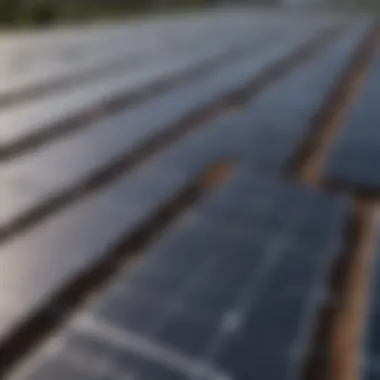Maximizing Energy Output from Solar Panels


Intro
In the current landscape of energy production, solar panels have emerged as a legitimate contender. With the rise of renewable energy sources, understanding their output potential is crucial for anyone looking to invest or enhance their energy options. Solar energy is not just a fad; it's a sustainable path that many households and businesses are exploring. Knowledge of how much energy can be harnessed through solar power isn’t merely academic—it’s a gateway into making informed decisions about investments and utility bills.
This article aims to dissect the components that impact solar panel efficiency and productivity. It will examine the technology itself, geographical considerations, and how the operational environment plays a role in energy output. Whether you're a seasoned investor looking to diversify your portfolio or a homeowner interested in reducing energy costs, this guide aims to provide critical insights for effective solar energy utilization.
Key Concepts and Definitions
A well-rounded understanding of solar energy production requires familiarity with certain key concepts.
Overview of Investment Terms
Investing in solar energy isn’t the same as buying conventional stocks or bonds. Here’s a run-through of terms that are frequently encountered in solar investments:
- Return on Investment (ROI): This figure indicates how much profit you can expect over your initial investment. In solar energy, this must factor in both installation costs and ongoing savings on energy bills.
- Payback Period: Refers to the time needed to recoup the initial investment through energy savings. The shorter, the better.
- Net Metering: This is a billing mechanism that credits solar energy system owners for the electricity they add to the grid.
- Incentives: Various government-backed incentives exist to help offset the costs of solar installation. These can include tax rebates and state-sponsored programs.
Significance of Understanding Financial Terminology
Being conversant with these terms is not just nice to know; it equips you for smarter negotiations and considerations when choosing solar panels and installation services. Knowing the financial metrics helps you weigh different options and makes it easier to communicate with providers about potential savings.
"Knowledge is power, and in today’s energy market, that power can translate into significant savings."
Understanding the financial aspect can also prepare you for potential pitfalls. Some solar panel providers may sketch a rosy picture, but having a grip on these terms allows you to question the validity of their claims effectively.
Expert Insights and Advice
Arming oneself with the right information is only part of the equation. Implementing effective investment strategies can make all the difference.
Investment Strategies for Beginners
New investors should consider starting small, possibly through community solar programs or lease agreements, which may require little to no upfront costs. Look for financing options that include:
- Power Purchase Agreements (PPAs): This allows homeowners to pay for solar energy instead of the system itself.
- Solar Loans: Different types of loans can make upfront payments manageable.
Researching local regulations and incentives is also essential. The savings can be substantial based on where you reside.
Advanced Techniques for Seasoned Investors
For those with experience in solar investments, consider employing strategies such as:
- Diversification of solar projects: Investing in multiple, geographically dispersed projects can mitigate risk.
- Comparative analysis: Look at performance data from various solar panel models and brands. High efficiency may come at a higher price, but it can be more cost-effective long-term.
- Partnerships: Collaborating with established energy firms can open doors to larger, more lucrative investments.
By understanding both the technical and financial landscapes surrounding solar energy, you can make more strategic decisions that align with your long-term goals. The journey into solar energy is as rewarding intellectually as it is financially.
Understanding Solar Panels
Understanding solar panels is crucial for anyone interested in harnessing renewable energy. They convert sunlight into electricity using specific technology and materials, making them a key player in sustainable energy practices. By investing time in understanding solar panels, individuals can make informed decisions that could lead to energy savings and reduced reliance on fossil fuels.
In terms of energy production, recognizing how solar panels work allows users to optimize their installations for maximum output. This encompasses everything from the type of panels selected to the geographic locations—an understanding of which can lead to better energy management and cost-effective solutions. Moreover, delving into the functionality and components of solar panels helps clarify what factors influence energy production, which will be especially beneficial for financial enthusiasts and investors.
Basic Functionality of Solar Panels
At the heart of solar panels is their functionality: capturing sunlight and converting it into electricity. This is primarily achieved through photovoltaic technology, which creates a flow of electricity as sunlight is absorbed. Solar panels can produce energy for homes, businesses, and larger grids, transforming how we approach our energy needs.
Key Components of Solar Panels
To grasp solar panels' energy production capabilities fully, it is essential to know their components. Here’s a closer look at three critical parts:
Photovoltaic Cells
Photovoltaic cells are the core of solar panel functionality. They are made from semiconductor materials, usually silicon-based, that convert sunlight directly into electricity through a process called the photovoltaic effect. Their main characteristic is efficiency in converting light to energy, which makes them a popular choice. They have excellent performance, often rated at producing between 15-22% efficiency in converting sunlight into usable power. However, their primary disadvantage can be their higher cost compared to other technology types.
Glass Cover
The glass cover protects the photovoltaic cells beneath it while allowing sunlight to pass through. Most panels use tempered glass, which is durable and weather-resistant. This ensures longevity and efficiency. The primary benefit of a sturdy glass cover is its ability to maintain the clarity for light absorption, ensuring minimal energy loss over time. However, if poorly installed or manufactured, cracks or scratches can affect energy conversion.
Backing Materials
Backing materials are crucial to providing structural support to solar panels. Usually made from a polymer or aluminum, the backing helps in thermal management and weather resistance. A key characteristic of quality backing materials is their insulation properties, which help improve the panel's energy efficiency by reducing heat loss. While they are typically long-lasting, cheaper backing materials can degrade faster, potentially leading to reduced performance over time.
Types of Solar Panels
Understanding the various types of solar panels available can significantly affect energy production outcomes. Here's a breakdown of the three major categories:
Monocrystalline Panels
Monocrystalline panels are often recognized for their high efficiency and sleek look. Made from a single crystal structure, they typically deliver higher energy output in smaller surface areas. Their ability to perform well in low-light conditions and generate around 20-25% efficiency makes them a beneficial choice. However, their higher price point can act as a barrier for some consumers.
Polycrystalline Panels
Polycrystalline panels are manufactured from multiple silicon crystals melted together. These panels are generally less expensive to produce than their monocrystalline peers, yet they also come with a slightly lower efficiency of about 15-20%. Their main advantage lies in affordability and performance, but the tradeoff can be less effective under high temperatures, which can slightly decrease output.
Thin-Film Panels
Thin-film panels represent an emerging technology that utilizes layers of photovoltaic material. They're noted for their lightweight and flexibility, making them suitable for various applications, from rooftops to portable solar devices. Their efficiency tends to be lower, ranging between 10-12%, but they can perform better in shady conditions and higher temperatures. This variety is increasingly popular for niche applications, although they take up more space for a similar energy output when compared to crystalline options.
Energy Production Factors
Understanding the factors that influence energy production in solar panels is crucial for those looking to invest or utilize solar energy more efficiently. These factors not only determine how much energy a solar panel can generate, but they also play a significant role in the system's overall performance and durability. By addressing these factors, one can enhance the return on investment in solar technology and maximize benefits, especially in regions with distinct climatic patterns.
Geographical Influence on Energy Output
A solar panel’s energy output is not universally applicable; geographic conditions weigh heavily on performance. This section breaks down the various influences that geographical location has on the energy produced.
Solar Irradiance Levels
Solar irradiance levels refer to the amount of solar power received per unit area. This critical aspect affects how effectively a solar panel can capture sunlight and convert it into energy. The key characteristic here is that regions with higher irradiance can significantly boost energy production compared to areas with lower irradiance.
One unique feature of solar irradiance levels is their direct correlation with daily and seasonal sunlight availability. For instance, places like the southwestern United States tend to receive ample sunlight throughout the year, making solar panels a popular energy source there. However, those in less sunny environments might find their energy production lagging.


Climate Conditions
The climate surrounding solar panels can alter their performance. You might think of climate primarily in terms of temperature; however, factors such as humidity, wind speed, and precipitation also matter. The essential element of climate is how it can enhance or hinder energy generation.
For instance, places with dry climates might find that solar panels perform exceptionally well, as there's less humidity to block sunlight. Nonetheless, in regions prone to snow or heavy rain, modifications might be necessary to ensure panels are kept clear and functional.
Latitude Implications
Latitude implications speak to how the angle of the sun changes with geographical location. Different latitudes have varying sun angles, influencing how much direct sunlight panels receive throughout the year. The significant characteristic here is that latitudes closer to the equator generally enjoy more consistent sunlight year-round. This consistency can be advantageous for maximizing energy production.
On the flip side, regions at higher latitudes experience more seasonal variations in daylight hours, which can lead to reduced energy output during certain times of the year. This makes understanding latitude implications vital for calculating potential energy yield and planning solar investments.
Solar Panel Orientation and Angle
The orientation and tilt angle of solar panels contribute significantly to their efficiency in harnessing sunlight. By understanding these aspects, one can enhance energy production further.
Optimal Tilt Angles
Optimal tilt angles refer to the angle at which solar panels are installed to catch the most sunlight. The importance of these angles cannot be overstated; improperly positioned panels can miss out on significant energy yields. Regions may benefit from varying optimal tilt angles, especially as seasons change.
A unique feature to consider is the fact that some systems allow for adjustable angles. This means during winter, panels can be tilted more steeply, while in summer, a flatter angle may capture sunlight more effectively. However, maintaining adjustability can increase installation complexity and cost, so it's key to weigh the trade-offs carefully.
Impact of Orientation
The orientation of solar panels, whether facing south, north, or east/west, substantially influences energy output. South-facing panels generally receive more direct sunlight in the northern hemisphere, while those facing east or west might be limited in their performance.
The essential insight here is that orientation can lead to significant differences in energy yield. For instance, an east-facing panel might generate more energy in the morning, while a west-facing one could peak in the afternoon. This variability can be both an advantage and a disadvantage depending on where you live and when you need the energy most.
Seasonal Variations
Seasonal variations affect sunlight quality and quantity, which in turn impacts solar energy production. During summer months, sunlight intensity and duration typically increase, allowing for higher power generation. In contrast, winter brings shorter days and often harsher weather that can reduce output.
What’s particularly noteworthy is that some systems are designed with these variations in mind, such as utilizing more efficient panels that can capture lower light levels during winter. However, the inconsistency of seasonal variations can make it harder to predict energy generation over the entire year.
Shading Effects
Shading can drastically reduce a solar panel’s ability to generate energy. This section pulls back the curtain on how varying levels of shading can affect overall performance.
Partial Shading
Partial shading refers to when solar panels are partially blocked by trees, buildings, or other obstacles. This can lead to a sharp decline in output. One of the significant features to note is that even a small amount of shading can disproportionately affect energy generation, due to the series wiring in most solar panels.
The main advantage in addressing partial shading is that strategic planting and well-thought-out placement of panels can optimize their performance. Picking the right location and ensuring there is minimal shading from surrounding obstacles is essential to ensure maximum efficiency.
Complete Shading
Complete shading, as the name suggests, means that solar panels receive no sunlight at all. This would entirely halt energy production, making it a dire situation for any solar investment.
The notable feature of complete shading is that it can often be avoided through careful planning. Homeowners might need to consider trimming branches or choosing rooftop placements wisely to prevent shading problems.
Mitigation Strategies
Mitigation strategies encompass various approaches to reduce the effects of shading on panels. These strategies can involve adjusting the layout of solar panels or using innovative technologies like microinverters and power optimizers. The primary characteristic of these technologies is their ability to function independently; so if one panel is shaded, the others can still generate power.
Implementing these strategies can be advantageous. Homeowners can mitigate potential losses due to shading, hence boosting overall energy output. At the same time, these strategies come with an increased initial cost, which is something to consider during the planning stage.
Understanding these factors related to energy production becomes increasingly vital as more individuals consider solar energy as a feasible option. The knowledge gained can pave the way for smarter choices and ultimately better energy efficiency.
Calculations of Energy Production
Calculating energy production from solar panels is a crucial piece of the puzzle when it comes to harnessing solar energy effectively. It helps homeowners, businesses, and investors understand exactly how much energy they can expect from their investment. These calculations allow one to assess the feasibility of solar projects, ensure financial viability, and estimate potential savings or returns from using renewable energy sources.
When we dig deeper into how calculations of energy production work, it becomes clear that various factors influence output rates. From the geographical positioning of a solar setup to the type of technology employed, every element plays a role. This section will elaborate on key aspects of estimating energy output and evaluating specific energy outputs, fundamentally offering insights that are crucial for any solar energy enthusiast.
Estimating Energy Output
Calculating Peak Sun Hours
Calculating peak sun hours represents a significant facet of estimating energy output from solar panels. This metric refers to the number of hours during which solar radiation is strong enough to be effectively harnessed by solar technology. A key characteristic of peak sun hours is its variability depending on geographic location and seasonal changes. This makes it a beneficial component, as knowing specific hours can significantly impact energy generation estimates.
The unique nature of peak sun hours lies in its ability to translate solar radiation levels into a more standardized measure. For instance, in sunny areas, the peak sun hours can be much higher compared to regions that often see cloudy weather.
Advantageously, using peak sun hours helps in optimizing solar panel orientation and tilt. However, it’s important to understand that relying solely on this measure can mislead if not contextualized with local weather patterns.
Understanding System Efficiency
An essential factor to consider in energy calculations is system efficiency. This concept measures how effective solar panel systems are in converting sunlight into usable electricity. A distinguishing trait of system efficiency is that it varies across different panel types and installations, making it crucial for accurate energy projections. In this article, understanding system efficiency is vital because it underscores the relationship between technology and output.
One unique feature of system efficiency is its dependency on both the quality of the solar panel and environmental conditions. For example, high-efficiency panels may perform poorly in extreme heat, while those with lower efficiency might yield better results in such climates. This creates a landscape where efficiency, while important, can also introduce challenges due to variability, particularly in real-world scenarios.
Using Online Calculators
Guided calculations using online tools offer a simple yet effective way to estimate energy production. These calculators take into account numerous variables—like location, system size, and orientation—to derive estimated energy output. A primary characteristic of online calculators is their user-friendly design, which allows individuals without advanced technical knowledge to interact with solar estimation easily.
The advantage of using these online resources lies in the speed and accuracy they can provide to energy estimates. Still, it’s essential to approach these results with caution. Online calculators may not always reflect local regulations or changes in environmental factors, which could influence the actual performance of solar systems.
Evaluating Specific Energy Output
Capacity Factor Analysis
Delving into capacity factor analysis reveals how effective a solar installation can be in actual scenarios compared to its theoretical maximum output. The capacity factor measures actual energy produced relative to the potential if the panels operated at peak capacity all the time. This metric becomes particularly significant because it takes into account maintenance downtimes, less-than-ideal weather, and other practical limitations.
The uniqueness of capacity factor analysis is that it can vary widely across different installations and geographical areas. In sunny, stable climates, one might find much higher capacity factors, whereas installations in less favorable weather may underperform. By understanding capacity factors, stakeholders can gauge the realistic performance of investments.
Real-World Data Examples
Real-world data examples serve as a valuable gauge for estimating energy production potential through case analyses of existing solar installations. This characteristic enhances one's understanding of practical performance versus estimates made in calculations. Learning from these examples can guide future projects and market approaches.
Notably, real-world data often reveals discrepancies between predictions and actual performance. Such insights can help adjust future forecasts and improve the accuracy of energy projections. Therefore, incorporating real-world examples into analyses represents a double-edged sword—offering transparency while also presenting variabilities that might complicate straightforward analyses.


Benchmarking Against Standards
Benchmarking against standards involves comparing performance metrics of solar systems against recognized benchmarks or best practices in the industry. This process encourages a standardized approach to measuring energy output and provides context to specific performance figures. By using benchmarks, stakeholders can identify underperforming systems and areas needing improvement.
A unique aspect of benchmarking is its ability to evolve with technological advancements. As new standards emerge, they can influence expectations about system performance and efficiencies in energy production. Therefore, this tool helps maintain relevance in a fast-evolving industry.
In summary, calculating energy production from solar technology encompasses a blend of estimations and real-world validations. It’s through these various analyses that investors and enthusiasts can chart a course toward effective solar energy utilization.
Impact of Technology on Energy Production
The impact of technology on energy production from solar panels cannot be overstated. As the solar industry evolves, advancements play a crucial role in maximizing the efficiency and viability of solar energy. Technology influences not just how much energy is produced, but also how that energy can be utilized. By improving output, reducing costs, and enhancing user experience, technological developments are pivotal in making solar energy a practical option for a wider audience.
Advancements in Solar Technology
High-Efficiency Panels
High-efficiency panels represent a significant leap in solar technology. These panels are designed to convert sunlight into energy with a greater efficiency rate than traditional models. A key characteristic of high-efficiency panels is their use of advanced materials and innovative designs, which enables them to capture more solar photons. While these panels come with a higher price tag, their long-term benefits make them popular among investors looking for reliable returns.
One unique feature of high-efficiency panels is their ability to outperform standard panels under various lighting conditions. This adaptability means they can deliver better performance in partially shaded areas or less-than-ideal weather. However, their elevated initial costs can be a barrier for some, though they are often justified by the increased energy output and potential savings on energy bills over time.
Bifacial Solar Panels
Bifacial solar panels stand out due to their ability to harness sunlight from both sides. This attribute allows them to generate more energy, particularly in environments where surface reflections are common. The key characteristic of bifacial panels is their dual-sided design, which makes them ideal for installations facing issues like limited space or the need for maximum output in suboptimal locations.
Their unique feature is their enhanced energy production; when placed over reflective surfaces, they can significantly increase performance. Certain disadvantages include their higher installation and mounting requirements. Despite these potential drawbacks, the increased energy output makes them a favorite among those looking to optimize their solar investments.
Concentrated Photovoltaics
Concentrated photovoltaics (CPV) provide a different approach by using lenses or mirrors to focus sunlight onto small, highly efficient solar cells. This method increases the amount of solar energy that can be collected in a given area. A notable characteristic of CPV is its capacity for high efficiency, making it particularly effective in sunny climates where sunlight is abundant.
One of the unique features of CPV systems is their ability to minimize the use of expensive solar cells by concentrating sunlight onto smaller areas. However, the system's reliance on direct sunlight means it’s less effective in cloudy weather, which can pose a challenge in regions with variable weather patterns. Despite this limitation, the potential to produce much more energy in optimal conditions is what makes CPV an attractive option.
Emerging Trends in Solar Technology
Integration with Energy Storage Systems
Integrating energy storage systems with solar panels can dramatically transform energy accessibility. This integration allows energy produced during peak sunlight hours to be stored and used when the sun isn't shining. The key characteristic here is the synergy between solar technology and battery storage, enhancing overall energy reliability.
A unique feature of this integration is the capability to smooth out energy supply, especially in regions with fluctuating energy needs or where grid reliability is a concern. However, costs associated with high-quality energy storage solutions might deter some adopters, but the potential for energy independence mitigates this.
Smart Solar Devices
Smart solar devices, which utilize Internet of Things (IoT) technology, are another exciting trend in the solar industry. These systems allow for improved monitoring and management of energy use and production in real-time. Their key characteristic is the ability to offer users insightful data, helping them optimize their energy consumption based on variable factors, like time of day and weather forecasts.
The unique feature of smart solar devices is automation, which contributes to making solar energy use more convenient and efficient. Nevertheless, the complexity and cost of these systems can be daunting for some users, potentially limiting accessibility. Despite these challenges, their benefits can significantly enhance energy management and sustainability.
Hybrid Systems
Hybrid systems are an innovative solution that combines different forms of energy generation, typically solar with other renewable sources or traditional energy grids. This combination can offer enhanced reliability and efficiency, making it a key characteristic of modern energy solutions.
A remarkable feature of hybrid systems is their flexibility to operate in numerous environments and circumstances. They can address the intermittency of solar power by integrating a dependable backup, be it from wind, hydro, or even fossil fuels when necessary. The main disadvantage is the complexity and cost of installation, demanding a higher level of initial investment for comprehensive setup. Still, their potential for long-term energy security makes them noteworthy in the discussions of future solar applications.
Technological advancements pave the way toward greater solar energy efficiency, making solar energy not just a trend, but a sustainable avenue for the future.
By understanding these assorted advancements and trends, those interested in solar panel energy production can make more informed choices about their investments and installations. Engaging with these evolving technologies will not just benefit individual households or businesses—it’s a crucial step towards a more sustainable future.
Financial Implications of Solar Investment
The topic of financial implications surrounding solar investments is crucial for understanding the overall viability of harnessing solar energy. It delves into the costs, benefits, and opportunities that come with investing in solar panels. Grasping these concepts can help potential investors and homeowners recognize the long-term value of solar energy, leading to well-informed decisions.
Cost-Benefit Analysis
Initial Investment Costs
When considering solar panels, the initial investment costs are often the first major factor that comes to mind. These costs typically encompass the price of purchasing solar panels, inverters, mounting systems, and installation fees. The key characteristic of initial investment costs is that they can be substantial, which may make some individuals hesitant. However, it's essential to remember that these upfront expenses are an investment toward sustainable energy for the future.
One unique feature of initial investment costs is their variability based on quality and brand. For instance, premium brands might offer higher efficiency but could come with a steeper price. This trade-off can lead to greater savings down the line. Yet, it's worth noting that financing options are often available, which can ease the financial burden for those keen on reducing their electricity bills.
Return on Investment
Return on investment, or ROI, is a crucial factor when evaluating the financial viability of solar installation. Simply put, ROI gauges how quickly the investment pays off compared to its costs. A beneficial aspect of examining ROI is that it highlights the potential savings on energy bills. In many areas, individuals can expect a return on their investment within a span of five to seven years, depending on local energy prices and system size.
One unique feature of ROI calculations is the consideration of rising electricity prices. If energy prices are expected to increase, the savings generated from solar energy could accelerate, thereby enhancing ROI. Nonetheless, prospective investors should consider potential disadvantages, such as fluctuations in energy policies or incentives that might affect their calculations.
Long-Term Savings
Long-term savings are arguably the most compelling reasons to invest in solar energy. With solar panels, homeowners can significantly reduce or even eliminate their electricity bills over time. The key characteristic is that these savings are not just immediate; they compound over the decades. Most solar systems have a lifespan of 25 years or more, ensuring an extensive period during which households can benefit financially.
What stands out about long-term savings is that many people often overlook other monthly expenses that solar energy can alleviate. For example, by offsetting energy costs, individuals can allocate those funds toward other investments or savings plans. However, one must also consider potential drawbacks such as maintenance costs or the need for system upgrades after years of use, which could eat into overall financial gains.
Incentives and Rebates
Government Subsidies
Government subsidies play a significant role in making solar investments more financially attractive. These incentives reduce the initial investment costs, which can prompt more people to consider solar energy. A key characteristic of these subsidies is that they can come in various forms, such as direct payments, tax credits, or rebate programs. This aspect motivates homeowners and businesses alike to explore solar solutions.
A particularly unique feature of these subsidies is that they not only lower costs at the outset but can also accelerate community adoption of solar technology. However, potential investors should keep in mind that subsidy frameworks can change, presenting a risk of reduced benefits in the future. Understanding local regulations and their timelines is critical for aspiring solar users.
Tax Credits
Tax credits provide another layer of financial incentive for those investing in solar energy. By reducing the taxable income, these credits can substantially lessen the cost of solar panel installation. This beneficial aspect of tax credits can help families save thousands—or at least hundreds—on their solar investment, creating a sense of urgency to act before tax incentives change.
The unique feature here is how various tax credits work differently depending on federal, state, and local laws. Potential investors should also be mindful of any eligibility criteria that may apply, which can require them to do their homework to fully capitalize on these financial tools. The downside is that once tax credits are expiring, it could impact future installations if individuals didn't take advantage of them early on.
Local Incentive Programs
Local governments often implement incentive programs aimed at promoting solar energy in their communities. These incentives can reduce individual installation costs, thus encouraging more participants in solar investments. One standout is that local programs can vary widely, from direct financial support to grants or interest-free loans. Such diversity in programs means potential solar users can often find something that aligns with their specific financial situation.
One unique highlight of these programs is their community focus; these initiatives often provide education and resources on solar energy. However, the challenge lies in the inconsistency of these offerings. Some regions may have robust programs, while others may offer minimal support. The existence of these programs can greatly influence overall investment decisions.


By sketching out these financial implications, potential investors can better weigh their options. It's a rich landscape filled with opportunities, but navigating it carefully is essential to ensure favorable outcomes.
Case Studies and Real-World Applications
Exploring the real-world applications of solar panels is essential to understanding their energy production potential. Case studies shed light on how various installations function under different conditions, providing invaluable insights into performance, cost, and efficiency. They illustrate both successes and challenges, giving potential investors and energy advocates a clearer picture of what solar energy can achieve. Moreover, these examples can inspire innovative solutions tailored to specific needs and environments. By diving into case studies, one can better grasp the tangible benefits solar energy brings, as well as the hurdles that come along the way.
Residential Solar Installations
Energy Savings in Homes
Energy savings in homes present a compelling aspect of residential solar installations. Homeowners can expect a noticeable drop in their electricity bills after installing solar panels. This reduction isn't merely a drop in cents; some families save hundreds of dollars annually. The sheer fact that residential solar systems can produce surplus energy, which may be sold back to the grid, makes them a sound investment. Additionally, by generating their own electricity, homeowners are cushioned against fluctuating energy prices.
One unique feature of such systems is net metering, which allows homeowners to receive credits for the electricity they contribute to the grid. However, while the savings can be significant, the initial cost of solar installation should not be overlooked, resulting in a longer payback period if financing options are not well understood.
System Configurations
System configurations play an essential role in maximizing energy production in a residential setting. Different setups, such as rooftop vs. ground-mounted installations, can significantly influence overall performance. Rooftop systems are often favored due to space constraints, but ground-mounted systems can often capture more sunlight, especially when installed at optimal angles.
The versatility of configurations means homeowners can customize their installations to fit specific needs, like using battery storage for nighttime energy use. Nonetheless, choosing the right configuration isn't always straightforward. Variations in roof pitch, shading from trees, or even aesthetic preferences can complicate decisions, leading to delays or higher costs.
Consumer Experiences
Consumer experiences with solar panels further illuminate their impact on energy production potential. Many homeowners express their satisfaction with both the savings and the positive environmental contributions of solar energy. They often report feeling empowered knowing that they are reducing their carbon footprint. This emotional connection to sustainability cannot be underestimated.
Yet, some consumers voice challenges such as the maintenance of solar panels and the necessity of occasional repairs. These experiences serve to highlight that while solar energy provides several benefits, there are practical considerations. Overall, the blend of user testimonials willing to share real experiences enriches the narrative surrounding solar adoption.
Commercial Solar Utilization
Grid-Tied Systems
Grid-tied systems are a cornerstone of commercial solar energy solutions. Their primary characteristic is the ability to connect directly to the power grid, allowing businesses to utilize solar energy while still having access to traditional electricity. This setup is particularly appealing due to its efficiency and reduced upfront costs, as businesses only have to cover the expense of their solar installation without the added burden of battery storage.
A noteworthy benefit is the capacity to sell excess energy back to the grid, creating an additional revenue stream for these establishments. However, the downside to this approach is the reliance on the grid; during outages, companies with purely grid-tied systems may find themselves without power, highlighting the need for backup solutions in some industries.
Decentralized Generation
Decentralized generation is an emerging trend in the commercial solar sector that allows businesses to generate their own power on-site, reducing reliance on traditional energy sources. This setup offers resilience against energy price volatility, presenting a compelling argument for companies seeking long-term savings.
The distinctive feature of decentralized systems is their localized energy production, which often results in minimal transmission losses. Yet, one factor that can complicate the situation is the varying regulations and policies that govern energy production in different regions, which can potentially impact the effectiveness and legality of such installations.
Large-Scale Projects
Large-scale projects represent a powerful showcase of solar capabilities on a grand scale. They typically involve multiple megawatts of solar panels and can significantly contribute to a region's energy mix. These setups often lead the charge in promoting renewable energy adoption, inspiring smaller entities to follow suit.
A key advantage of large-scale installations is the economies of scale. Bigger projects can drive down the cost per watt, making solar energy not only more competitive but also allowing significant returns for investors. However, such extensive projects can face hurdles, such as land acquisition or grid connection delays. As with any large endeavor, navigating local regulations can be challenging and requires thorough planning and sometimes flexibility in design.
Future Prospects in Solar Energy Production
The shifting landscape of solar energy production holds substantial promise for both investors and the environment. As we glance toward the horizon, developments on many fronts shape the future of solar energy. Crucial elements include advances in technology, expanding markets, and the increasing necessity of sustainable energy solutions. This section dives into several factors that come together to forge opportunities and challenges within this evolving domain.
Emerging Markets and Opportunities
Developing Economies
Developing economies are stepping up as significant players in the solar energy arena. One major aspect is their urgent need for reliable power sources to stimulate economic growth. The key characteristic of developing nations typically involves high energy demand due to rapid urbanization. This makes solar energy an appealing option given its scalability.
- Advantages:
- Cost-Effectiveness: With declining solar panel costs, even countries with limited financial resources can invest in solar infrastructure.
- Job Creation: New solar projects generate local jobs, creating economic activity in underserved regions.
However, the financing and maintenance of solar installations can be hurdles, particularly in rural areas where access to technology and expertise is sparse.
Community Solar Projects
Community solar projects represent a grassroots approach to energy distribution, wherein local communities invest collectively in solar panel installations. This method accentuates the idea that energy can be harnessed and consumed locally, directly benefiting the community.
- Characteristics:
- Inclusivity: These projects often allow individuals, even those who cannot afford private installations, to engage in solar energy through shared resources, promoting social equity.
- Flexibility: Residents can subscribe to a portion of a larger solar farm, allowing them to reap benefits without the full burden of ownership.
Nevertheless, local regulations and financing issues can present barriers that challenge project success in some areas.
Global Solar Initiatives
Various global initiatives underline the commitment to solar energy on a larger scale. Organizations and countries are collaborating, resulting in projects that can transcend geographical limitations. One major element here is international partnerships aimed at deploying large solar infrastructures in areas with abundant sunlight but lacking energy access.
- Key Features:
- International Cooperation: Nations combine resources for joint solar projects, optimizing investments and technology sharing.
- Sustainable Development Goals: Many initiatives align with the United Nations' sustainability goals, providing a pathway to reduce carbon emissions globally.
While these initiatives can spark significant progress, they may also face challenges such as geopolitical tensions and differing regulatory environments.
Challenges and Considerations
Environmental Impacts
Every technology, including solar, comes with environmental concerns. The manufacturing and disposal of solar panels can lead to pollution if not managed correctly. But, on balance, solar energy is a far cleaner option compared to fossil fuels.
- Key Factor:
- Life Cycle Assessments: These evaluations detail the environmental impact from solar panel production, usage, and disposal. They are essential in ensuring that the switch to solar doesn’t inadvertently create other issues.
Resource Limitations
The materials used in solar technology also raise questions. For instance, rare minerals necessary for producing efficient panels are finite and can lead to environmental degradation if extraction is unchecked.
- Consideration:
- Responsible Sourcing: There is a growing call for companies to adopt ethical mining practices to ensure sustainability within the industry.
Grid Integration Issues
With solar energy increasingly part of the grid, challenges arise regarding integration. Managing the balance of supply and demand requires sophisticated technology.
- Key Characteristic:
- Smart Grid Development: Integration of renewable sources like solar necessitates the evolution of our electrical grids to handle variability and ensure reliability.















